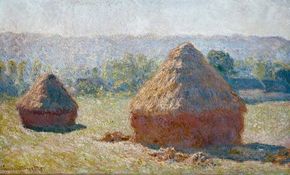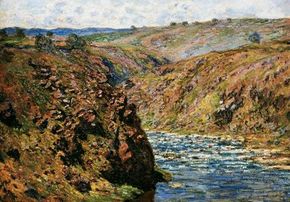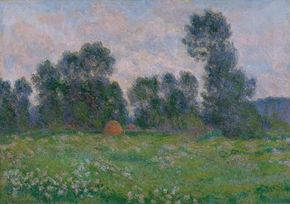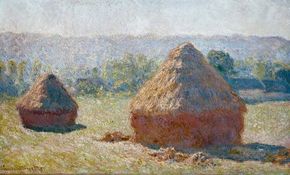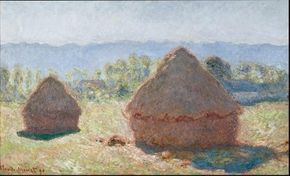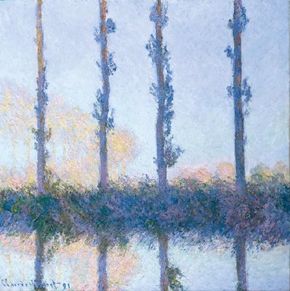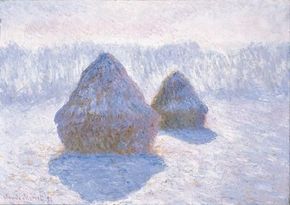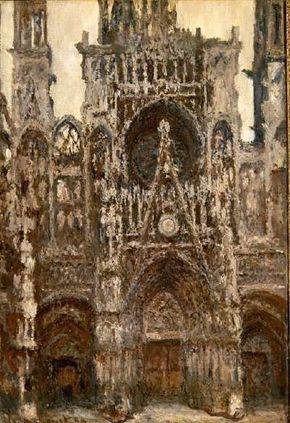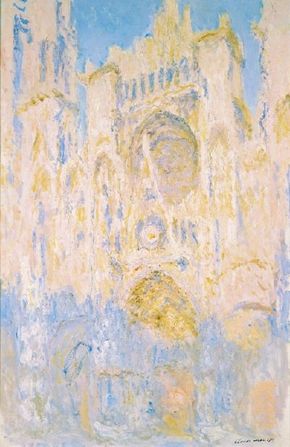Claude Monet's travels in the 1880's had refined his idea of a series. Monet began to direct his attention to a particular feature of the landscape so he could observe the subtle variations in color and illumination over the course of a day. He employed several canvases to capture a single view, switching from one to the next as the light changed.
He now sought to intensify this experience by reducing his options among the factors he could control -- subject, angle, position of easel -- to better comprehend the infinite modulation of tone as light passed over a surface. An effect might only last a moment; the slightest shift of the light source would alter colors, tonality, and the dimensions of the shadows.
Advertisement
Monet had realized that light transformed the essential appearance of his subject. To understand it -- and to realize it on his canvas -- required that he address the subject again and again, if only to capture an instantaneous observation within the infinite range of visual possibilities.
In October 1890, Monet wrote to his friend the writer Gustave Geoffroy that the project he had undertaken was posing unexpected problems. The autumn sun set quickly, and he found that his brush and his eye were not swift enough to record what he had observed. Monet was painting stacks of wheat.
Two years earlier he had become intrigued with the way the local farmers stored their wheat in large mounds in the cleared fields outside Giverny. The rounded contour of the stack suggested to him a stable "envelope" that would be transformed by the fugitive effects of the sun's illumination as it moved east to west in the sky at a slightly different angle each day of the year.
As he worked on the Channel coast, on the Riviera, and in Britanny, Monet began to direct his attention to a particular feature of the landscape so he could observe the subtle variations in color and illumination over the course of a day. He employed several canvases to capture a single view, switching from one to the next as the light changed.
But the volatile weather kept Monet's subject vital and in flux, and he worked to the point of exhaustion. By early April, his energy was spent, and he returned to Giverny having painted 30 works over the course of his two campaigns. Cézanne visited Giverny that November, and he was astonished to see Monet's new work.
Always driven, Monet dismissed his own efforts, convinced he was in pursuit of something that would remain beyond his grasp. But the acuity of his observations and the intensity with which he engaged his subject prompted Cézanne to declare that Monet commanded "the only eye and the only hand that can follow a sunset in its every transparency and express its nuances on the canvas."
See how Claude Monet captures the essence of nature at various stages:
- Claude Monet's Valley of the Creuse (Sunlight Effect) utilizes a purple palette, deep purple shadows and pale violet highlights. See Monet's early obsession with light and water in Valley of the Creuse (Sunlight Effect).
- Claude Monet's Prairie a Giverny is a result of Monet curtailing his travel and observing the world around him. Check out Monet's Prairie a Giverny.
- Haystacks: End of Summer by Claude Monet captures the beauty of the late August sun. Discover Monet's Haystacks: End of Summer.
- Grainstacks in Bright Sun by Claude Monet uses dramatic colors to capture the natural perception of the light. Learn more about Claude Monet's Grainstacks in Bright Sun.
- Stack of Wheat (Thaw, Sunset) by Claude Monet portrays the effects of the late winter thaw. Learn more about Monet's Stack of Wheat (Thaw, Sunset).
- Claude Monet's Poplars, White and Yellow Effect suggests the stirring of a mild breeze through Monet's lively stroke. Check out Monet's Poplars, White and Yellow Effect.
- Claude Monet's painting Four Trees illustrates his venture into alternative borders and uses of light. Learn more about Monet's painting, Four Trees.
- Claude Monet's preoccupation with Grainstacks, Effect of Snow and Rain caused him to put all of his other paintings aside in order to capture the effects of winter. Learn about Claude Monet's obsessive focus on Grainstacks, Effect of Snow and Rain.
- Poplars on the Banks of the River Epte by Claude Monet was almost never completed. Find out more behind Monet's painting, Poplars on the Banks of the River Epte.
- Claude Monet's The Portal, Harmony in Brown was painted from his apartment window, giving a unique point of view to the work. See Monet's The Portal, Harmony in Brown.
- Rouen Cathedral, Morning Sun, Blue Harmony by Claude Monet could only be truly appreciated by accepting the individual canvas as part of the whole series. Check out Rouen Cathedral, Morning Sun, Blue Harmony by Claude Monet.
- Rouen Cathedral at the End of the Day (Sunlight Effect) was one of Claude Monet's more demanding works. See the fruit of Monet's labor in Rouen Cathedral at the End of the Day (Sunlight Effect).
See how Monet handles sunlight effects in the next section where we'll show you the Valley of the Creuse.To learn more about art, famous artists, and art history, check out:
Advertisement
